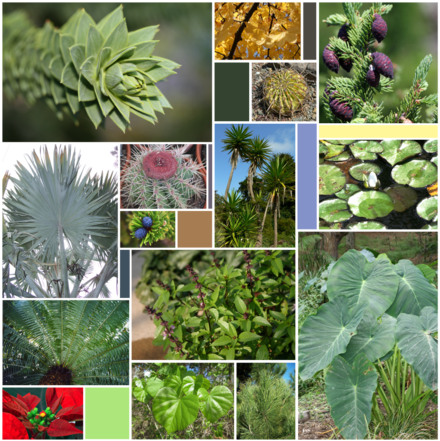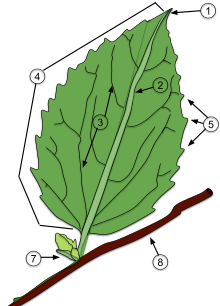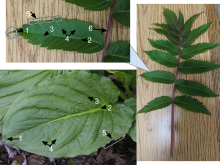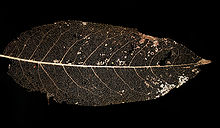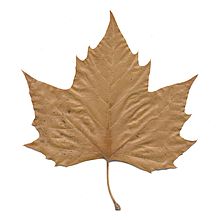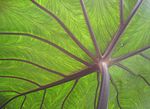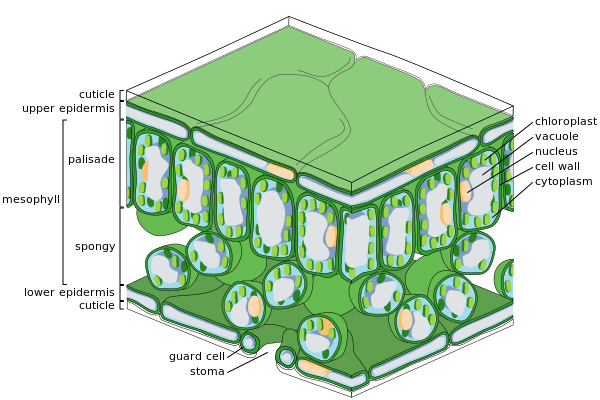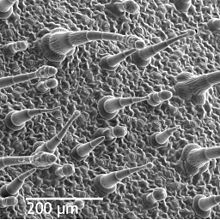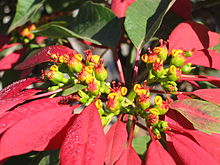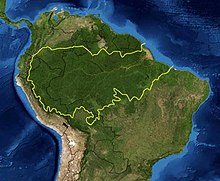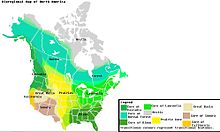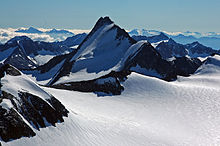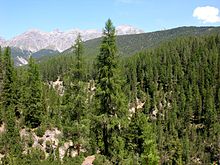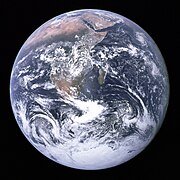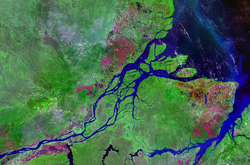The diversity of leaves
Leaf of Tilia tomentosa (Silver lime tree)
A leaf is an organ of a vascular plant and is the principal lateral appendage of the stem. The leaves and stem together form the shoot. Leaves are collectively referred to as foliage, as in "autumn foliage".
Diagram of a simple leaf.
- Apex
- Midvein (Primary vein)
- Secondary vein.
- Lamina.
- Leaf margin
- Petiole
- Bud
- Stem
Top and Right: Staghorn Sumac, Rhus typhina (Compound Leaf)
Bottom: Skunk Cabbage, Symplocarpus foetidus (Simple Leaf)
1. Apex
2. Primary Vein
3. Secondary Vein
4. Lamina
5. Leaf Margin
6. Petiole
Bottom: Skunk Cabbage, Symplocarpus foetidus (Simple Leaf)
1. Apex
2. Primary Vein
3. Secondary Vein
4. Lamina
5. Leaf Margin
6. Petiole
A leaf is a dorsiventrally flattened organ, usually borne above ground and specialized for photosynthesis. In most leaves, the primary photosynthetic tissue, the palisade mesophyll, is located on the upper side of the blade or lamina of the leaf but in some species, including the mature foliage of Eucalyptus,
palisade mesophyll is present on both sides and the leaves are said to
be isobilateral. Most leaves have distinct upper surface (adaxial) and lower surface (abaxial) that differ in color, hairiness, the number of stomata (pores that intake and output gases), the amount and structure of epicuticular wax and other features. Leaves are mostly green in color. This is due
to the presence of a compound called chlorophyll. This compound is essential for photosynthesis as it absorbs light energy from the sun.
A leaf with white patches or edges is called a variegated leaf.
Leaves can have many different shapes, sizes, and textures. The broad, flat leaves with complex venation of flowering plants are known as megaphylls and the species that bear them, the majority, as broad-leaved or megaphyllous plants. In the clubmosses, with different evolutionary origins, the leaves are simple (with only a single vein) and are known as microphylls. Some leaves, such as bulb
scales, are not above ground. In many aquatic species, the leaves are
submerged in water. Succulent plants often have thick juicy leaves, but
some leaves are without major photosynthetic function and may be dead at
maturity, as in some cataphylls and spines.
Furthermore, several kinds of leaf-like structures found in vascular
plants are not totally homologous with them. Examples include flattened
plant stems called phylloclades and cladodes, and flattened leaf stems called phyllodes which differ from leaves both in their structure and origin. Some structures of non-vascular plants look and function much like leaves. Examples include the phyllids of mosses and liverworts.
General characteristics
Leaves are the most important organs of most vascular plants. Green plants are autotrophic, meaning that they do not obtain food from other living things but instead create their own food by photosynthesis. They capture the energy in sunlight and use it to make simple sugars, such as glucose and sucrose, from carbon dioxide and water. The sugars are then stored as starch, further processed by chemical synthesis into more complex organic molecules such as proteins or cellulose, the basic structural material in plant cell walls, or metabolized by cellular respiration to provide chemical energy to run cellular processes. The leaves draw water from the ground in the transpiration stream through a vascular conducting system known as xylem and obtain carbon dioxide from the atmosphere by diffusion through openings called stomata in the outer covering layer of the leaf (epidermis),
while leaves are orientated to maximize their exposure to sunlight.
Once sugar has been synthesized, it needs to be transported to areas of
active growth such as the plant shoots and roots. Vascular plants transport sucrose in a special tissue called the phloem.
The phloem and xylem are parallel to each other, but the transport of
materials is usually in opposite directions. Within the leaf these
vascular systems branch (ramify) to form veins which supply as much of
the leaf as possible, ensuring that cells carrying out photosynthesis are close to the transportation system.
Typically leaves are broad, flat and thin (dorsiventrally
flattened), thereby maximising the surface area directly exposed to
light and enabling the light to penetrate the tissues and reach the chloroplasts,
thus promoting photosynthesis. They are arranged on the plant so as to
expose their surfaces to light as efficiently as possible without
shading each other, but there are many exceptions and complications. For
instance, plants adapted to windy conditions may have pendent leaves, such as in many willows and eucalyptss. The flat, or laminar, shape also maximizes thermal contact with the surrounding air, promoting cooling. Functionally, in addition to carrying out photosynthesis, the leaf is the principal site of transpiration, providing the energy required to draw the transpiration stream up from the roots, and guttation.
Many gymnosperms have thin needle-like or scale-like leaves that
can be advantageous in cold climates with frequent snow and frost. These are interpreted as reduced from megaphyllous leaves of their Devonian ancestors. Some leaf forms are adapted to modulate the amount of light they absorb to avoid or mitigate excessive heat, ultraviolet damage, or desiccation, or to sacrifice light-absorption efficiency in favor of protection from herbivory. For xerophytes the major constraint is not light flux or intensity, but drought. Some window plants such as Fenestraria species and some Haworthia species such as Haworthia tesselata and Haworthia truncata are examples of xerophytes. and Bulbine mesembryanthemoides.
Leaves also function to store chemical energy and water (especially in succulents) and may become specialized organs serving other functions, such as tendrils of peas and other legumes, the protective spines of cacti and the insect traps in carnivorous plants such as Nepenthes and Sarracenia.
Leaves are the fundamental structural units from which cones are
constructed in gymnosperms (each cone scale is a modified megaphyll leaf
known as a sporophyll) and from which flowers are constructed in flowering plants.
Vein skeleton of a leaf. Veins contain lignin that make them harder to degrade for microorganisms.
The internal organization of most kinds of leaves has evolved to maximize exposure of the photosynthetic organelles, the chloroplasts, to light and to increase the absorption of carbon dioxide while at the same time controlling water loss. Their surfaces are waterproofed by the plant cuticle
and gas exchange between the mesophyll cells and the atmosphere is
controlled by minute (length and width measured in tens of µm) openings
called stomata which open or close to regulate the rate exchange of carbon dioxide, oxygen, and water vapor into and out of the internal intercellular space system. Stomatal opening is controlled by the turgor pressure in a pair of guard cells that surround the stomatal aperture. In any square centimeter of a plant leaf, there may be from 1,000 to 100,000 stomata.
Near the ground these Eucalyptus
saplings have juvenile dorsiventral foliage from the previous year, but
this season their newly sprouting foliage is isobilateral, like the
mature foliage on the adult trees above
The shape and structure of leaves vary considerably from species to
species of plant, depending largely on their adaptation to climate and
available light, but also to other factors such as grazing animals (such
as deer), available nutrients, and ecological competition from other
plants. Considerable changes in leaf type occur within species, too, for
example as a plant matures; as a case in point Eucalyptus species commonly have isobilateral, pendent leaves when mature and dominating their neighbors; however, such trees tend to have erect or horizontal dorsiventral leaves as seedlings, when their growth is limited by the available light.
Other factors include the need to balance water loss at high
temperature and low humidity against the need to absorb atmospheric
carbon dioxide. In most plants, leaves also are the primary organs
responsible for transpiration and guttation (beads of fluid forming at leaf margins).
Leaves can also store food and water, and are modified accordingly to meet these functions, for example in the leaves of succulent plants and in bulb scales. The concentration of photosynthetic structures in leaves requires that they be richer in protein, minerals, and sugars than, say, woody stem tissues. Accordingly, leaves are prominent in the diet of many animals.
A leaf shed in autumn.
Correspondingly, leaves represent heavy investment on the part of the
plants bearing them, and their retention or disposition are the subject
of elaborate strategies for dealing with pest pressures, seasonal
conditions, and protective measures such as the growth of thorns and the
production of phytoliths, lignins, tannins and poisons.
Deciduous
plants in frigid or cold temperate regions typically shed their leaves
in autumn, whereas in areas with a severe dry season, some plants may
shed their leaves until the dry season ends. In either case, the shed
leaves may be expected to contribute their retained nutrients to the
soil where they fall.
In contrast, many other non-seasonal plants, such as palms and conifers, retain their leaves for long periods; Welwitschia retains its two main leaves throughout a lifetime that may exceed a thousand years.
The leaf-like organs of Bryophytes (e.g., mosses and liverworts), known as phyllids,
differ morphologically from the leaves of vascular plants in that they
lack vascular tissue, are usually only a single cell thick and have no cuticle stomata or internal system of intercellular spaces.
Simple, vascularized leaves (microphylls) first evolved as enations, extensions of the stem, in clubmosses such as Baragwanathia during the Silurian period. True leaves or euphylls of larger size and with more complex venation did not become widespread in other groups until the Devonian period,
by which time the carbon dioxide concentration in the atmosphere had
dropped significantly. This occurred independently in several separate
lineages of vascular plants, in progymnosperms like Archaeopteris, in Sphenopsida, ferns and later in the gymnosperms and angiosperms. Euphylls are also referred to as macrophylls or megaphylls (large leaves).
Morphology (large-scale features)
A structurally complete leaf of an angiosperm consists of a petiole (leaf stalk), a lamina (leaf blade), and stipules
(small structures located to either side of the base of the petiole).
Not every species produces leaves with all of these structural
components. Stipules may be conspicuous (e.g. beans and roses), soon falling or otherwise not obvious as in Moraceae or absent altogether as in the Magnoliaceae.
A petiole may be absent, or the blade may not be laminar (flattened).
The tremendous variety shown in leaf structure (anatomy) from species to
species is presented in detail below under morphology.
The petiole mechanically links the leaf to the plant and provides the
route for transfer of water and sugars to and from the leaf. The lamina
is typically the location of the majority of photosynthesis. The upper (adaxial) angle between a leaf and a stem is known as the axil of the leaf. It is often the location of a bud. Structures located there are called "axillary".
Translucent glands in Citrus leaves
External leaf characteristics, such as shape, margin, hairs, the
petiole, and the presence of stipules and glands, are frequently
important for identifying plants to family, genus or species levels, and botanists have developed a rich terminology
for describing leaf characteristics. Leaves almost always have
determinate growth. They grow to a specific pattern and shape and then
stop. Other plant parts like stems or roots have non-determinate growth,
and will usually continue to grow as long as they have the resources to
do so.
The type of leaf is usually characteristic of a species
(monomorphic), although some species produce more than one type of leaf
(dimorphic or polymorphic). The longest leaves are those of the Raffia palm, R. regalis which may be up to 25 m (82 ft) long and 3 m (9.8 ft) wide. The terminology associated with the description of leaf morphology is presented, in illustrated form, at Wikibooks.
Prostrate leaves in Crossyne guttata
Where leaves are basal, and lie on the ground, they are referred to as prostrate.
Basic leaf types
Leaves of the White Spruce (Picea glauca) are needle-shaped and their arrangement is spiral
- Ferns have fronds
- Conifer leaves are typically needle- or awl-shaped or scale-like
- Angiosperm (flowering plant) leaves: the standard form includes stipules, a petiole, and a lamina
- Lycophytes have microphyll leaves.
- Sheath leaves (type found in most grasses and many other monocots)
- Other specialized leaves (such as those of Nepenthes, a pitcher plant)
Arrangement on the stem
Different terms are usually used to describe the arrangement of leaves on the stem (phyllotaxis):
The leaves on this plant are arranged in pairs opposite one another, with successive pairs at right angles to each other (decussate) along the red stem. Note the developing buds in the axils of these leaves.
- Alternate
- One leaf, branch, or flower part attaches at each point or node on the stem, and leaves alternate direction, to a greater or lesser degree, along the stem.
- Basal
- Arising from the base of the stem.
- Cauline
- Arising from the aerial stem.
- Opposite
- Two leaves, branches, or flower parts attach at each point or node on the stem. Leaf attachments are paired at each node and decussate if, as typical, each successive pair is rotated 90° progressing along the stem.
- Whorled, or verticillate
- Three or more leaves, branches, or flower parts attach at each point or node on the stem. As with opposite leaves, successive whorls may or may not be decussate, rotated by half the angle between the leaves in the whorl (i.e., successive whorls of three rotated 60°, whorls of four rotated 45°, etc.). Opposite leaves may appear whorled near the tip of the stem. Pseudoverticillate describes an arrangement only appearing whorled, but not actually so.
- Rosulate
- Leaves form a rosette.
- Rows
- The term, distichous, literally means two rows. Leaves in this arrangement may be alternate or opposite in their attachment. The term, 2-ranked, is equivalent. The terms, tristichous and tetrastichous, are sometimes encountered. For example, the "leaves" (actually microphylls) of most species of Selaginella are tetrastichous, but not decussate.
As a stem grows, leaves tend to appear arranged around the stem in a way that optimizes yield of light. In essence, leaves form a helix pattern centered around the stem, either clockwise or counterclockwise,
with (depending upon the species) the same angle of divergence. There
is a regularity in these angles and they follow the numbers in a Fibonacci sequence: 1/2, 2/3, 3/5, 5/8, 8/13, 13/21, 21/34, 34/55, 55/89. This series tends to the golden angle, which is approximately 360° × 34/89 ≈ 137.52° ≈ 137° 30′. In the series, the numerator
indicates the number of complete turns or "gyres" until a leaf arrives
at the initial position and the denominator indicates the number of
leaves in the arrangement. This can be demonstrated by the following:
- Alternate leaves have an angle of 180° (or 1/2)
- 120° (or 1/3): 3 leaves in 1 circle
- 144° (or 2/5): 5 leaves in 2 gyres
- 135° (or 3/8): 8 leaves in 3 gyres.
Divisions of the blade
A leaf with laminar structure and pinnate venation
Two basic forms of leaves can be described considering the way the blade (lamina) is divided. A simple leaf has an undivided blade. However, the leaf may be dissected to form lobes, but the gaps between lobes do not reach to the main vein. A compound leaf has a fully subdivided blade, each leaflet
of the blade being separated along a main or secondary vein. The
leaflets may have petiolules and stipels, the equivalents of the
petioles and stipules of leaves. Because each leaflet can appear to be a
simple leaf, it is important to recognize where the petiole occurs to
identify a compound leaf. Compound leaves are a characteristic of some
families of higher plants, such as the Fabaceae. The middle vein of a compound leaf or a frond, when it is present, is called a rachis.
- Palmately compound
- Leaves have the leaflets radiating from the end of the petiole, like fingers of the palm of a hand; for example, Cannabis (hemp) and Aesculus (buckeyes).
- Pinnately compound
- Leaves have the leaflets arranged along the main or mid-vein.
- Bipinnately compound
- Leaves are twice divided: the leaflets are arranged along a secondary vein that is one of several branching off the rachis. Each leaflet is called a pinnule. The group of pinnules on each secondary vein forms a pinna; for example, Albizia (silk tree).
- Trifoliate (or trifoliolate)
- A pinnate leaf with just three leaflets; for example, Trifolium (clover), Laburnum (laburnum), and some species of Toxicodendron (for instance, poison ivy).
- Pinnatifid
- Pinnately dissected to the central vein, but with the leaflets not entirely separate; for example, Polypodium, some Sorbus (whitebeams). In pinnately veined leaves the central vein in known as the midrib.
Characteristics of the petiole
The overgrown petioles of rhubarb (Rheum rhabarbarum) are edible.
Sessile (epetiolate) leaves have no petiole and the blade attaches directly to the stem. Subpetiolate leaves are nearly petiolate or have an extremely short petiole and may appear to be sessile.
In clasping or decurrent leaves, the blade partially surrounds the stem.
When the leaf base completely surrounds the stem, the leaves are said to be perfoliate, such as in Eupatorium perfoliatum.
In peltate leaves, the petiole attaches to the blade inside the blade margin.
In some Acacia species, such as the koa tree (Acacia koa), the petioles are expanded or broadened and function like leaf blades; these are called phyllodes. There may or may not be normal pinnate leaves at the tip of the phyllode.
A stipule, present on the leaves of many dicotyledons, is an appendage on each side at the base of the petiole, resembling a small leaf. Stipules may be lasting and not be shed (a stipulate leaf, such as in roses and beans), or be shed as the leaf expands, leaving a stipule scar on the twig (an exstipulate leaf). The situation, arrangement, and structure of the stipules is called the "stipulation".
- Free, lateral
- As in Hibiscus.
- Adnate
- Fused to the petiole base, as in Rosa.
- Ochreate
- Provided with ochrea, or sheath-formed stipules, as in Polygonaceae; e.g., rhubarb.
- Encircling the petiole base
-
- Interpetiolar
- Between the petioles of two opposite leaves, as in Rubiaceae.
- Intrapetiolar
- Between the petiole and the subtending stem, as in Malpighiaceae.
Veins
Branching veins on underside of taro leaf
The venation within the bract of a lime tree
Micrograph of a leaf skeleton
The vein or veins entering the leaf from the petiole are called primary or first order veins. The veins branching from these are secondary or second order veins. These primary and secondary veins are considered major veins or lower order veins, though some authors include third order. Each subsequent branching is sequentially numbered, and these are the higher order veins, each branching being associated with a narrower vein diameter. In parallel veined leaves, the primary veins run parallel and equidistant to each other for most of the length of the leaf and then converge or fuse (anastomose) towards the apex. Usually, many smaller minor veins interconnect these primary veins, but may terminate with very fine vein endings in the mesophyll. Minor veins are more typical of angiosperms, which may have as many as four higher orders. In contrast, leaves with reticulate venation there is a single (sometimes more) primary vein in the centre of the leaf, referred to as the midrib or costa and is continuous with the vasculature of the petiole more proximally. The midrib then branches to a number of smaller secondary veins, also known as second order veins, that extend toward the leaf margins. These often terminate in a hydathode, a secretory organ, at the margin. In turn, smaller veins branch from the secondary veins, known as tertiary or third order (or higher order) veins, forming a dense reticulate pattern. The areas or islands of mesophyll lying between the higher order veins, are called areoles. Some of the smallest veins (veinlets) may have their endings in the areoles, a process known as areolation. These minor veins act as the sites of exchange between the mesophyll and the plant's vascular system. Thus, minor veins collect the products of photosynthesis (photosynthate) from the cells where it takes place, while major veins are responsible for its transport outside of the leaf. At the same time water is being transported in the opposite direction.
The number of vein endings is very variable, as is whether second order veins end at the margin, or link back to other veins. There are many elaborate variations on the patterns that the leaf veins form, and these have functional implications. Of these, angiosperms have the greatest diversity. Within these the major veins function as the support and distribution network for leaves and are correlated with leaf shape. For instance, the parallel venation found in most monocots correlates with their elongated leaf shape and wide leaf base, while reticulate venation is seen in simple entire leaves, while digitate leaves typically have venation in which three or more primary veins diverge radially from a single point.
In evolutionary terms, early emerging taxa tend to have dichotomous branching with reticulate systems emerging later. Veins appeared in the Permian period (299–252 mya), prior to the appearance of angiosperms in the Triassic (252–201 mya), during which vein hierarchy appeared enabling higher function, larger leaf size and adaption to a wider vaiety of climatic conditions. Although it is the more complex pattern, branching veins appear to be plesiomorphic and in some form were present in ancient seed plants as long as 250 million years ago. A pseudo-reticulate venation that is actually a highly modified penniparallel one is an autapomorphy of some Melanthiaceae, which are monocots; e.g., Paris quadrifolia (True-lover's Knot). In leaves with reticulate venation, veins form a scaffolding matrix imparting mechanical rigidity to leaves.
Morphology changes within a single plant
- Homoblasty
- Characteristic in which a plant has small changes in leaf size, shape, and growth habit between juvenile and adult stages, in contrast to;
- Heteroblasty
- Characteristic in which a plant has marked changes in leaf size, shape, and growth habit between juvenile and adult stages.
Anatomy (medium and small scale)
Medium-scale features
Leaves are normally extensively vascularized and typically have networks of vascular bundles containing xylem, which supplies water for photosynthesis, and phloem, which transports the sugars produced by photosynthesis. Many leaves are covered in trichomes (small hairs) which have diverse structures and functions.Small-scale features
The major tissue systems present are- The epidermis, which covers the upper and lower surfaces
- The mesophyll tissue inside the leaf, which is rich in chloroplasts (also called chlorenchyma)
- The arrangement of veins (the vascular tissue)
Major leaf tissues
Epidermis
SEM image of the leaf epidermis of Nicotiana alata, showing trichomes (hair-like appendages) and stomata (eye-shaped slits, visible at full resolution).
The epidermis tissue includes several differentiated cell types; epidermal cells, epidermal hair cells (trichomes), cells in the stomatal complex; guard cells and subsidiary cells. The epidermal cells are the most numerous, largest, and least specialized and form the majority of the epidermis. They are typically more elongated in the leaves of monocots than in those of dicots.
Chloroplasts are generally absent in epidermal cells, the exception being the guard cells of the stomata. The stomatal pores perforate the epidermis and are surrounded on each side by chloroplast-containing guard cells, and two to four subsidiary cells that lack chloroplasts, forming a specialized cell group known as the stomatal complex. The opening and closing of the stomatal aperture is controlled by the stomatal complex and regulates the exchange of gases and water vapor between the outside air and the interior of the leaf. Stomata therefore play the important role in allowing photosynthesis without letting the leaf dry out. In a typical leaf, the stomata are more numerous over the abaxial (lower) epidermis than the adaxial (upper) epidermis and are more numerous in plants from cooler climates.
Mesophyll
Most of the interior of the leaf between the upper and lower layers of epidermis is a parenchyma (ground tissue) or chlorenchyma tissue called the mesophyll (Greek for "middle leaf"). This assimilation tissue is the primary location of photosynthesis in the plant. The products of photosynthesis are called "assimilates".In ferns and most flowering plants, the mesophyll is divided into two layers:
- An upper palisade layer of vertically elongated cells, one to two cells thick, directly beneath the adaxial epidermis, with intercellular air spaces between them. Its cells contain many more chloroplasts than the spongy layer. These long cylindrical cells are regularly arranged in one to five rows. Cylindrical cells, with the chloroplasts close to the walls of the cell, can take optimal advantage of light. The slight separation of the cells provides maximum absorption of carbon dioxide. Sun leaves have a multi-layered palisade layer, while shade leaves or older leaves closer to the soil are single-layered.
- Beneath the palisade layer is the spongy layer. The cells of the spongy layer are more branched and not so tightly packed, so that there are large intercellular air spaces between them for oxygen and carbon dioxide to diffuse in and out of during respiration and photosynthesis. These cells contain fewer chloroplasts than those of the palisade layer. The pores or stomata of the epidermis open into substomatal chambers, which are connected to the intercellular air spaces between the spongy and palisade mesophyll cells.
Vascular tissue
The veins of a bramble leaf
The veins are the vascular tissue of the leaf and are located in the spongy layer of the mesophyll. The pattern of the veins is called venation. In angiosperms the venation is typically parallel in monocotyledons and forms an interconnecting network in broad-leaved plants. They were once thought to be typical examples of pattern formation through ramification, but they may instead exemplify a pattern formed in a stress tensor field.
A vein is made up of a vascular bundle. At the core of each bundle are clusters of two distinct types of conducting cells:
- Xylem
- Cells that bring water and minerals from the roots into the leaf.
- Phloem
- Cells that usually move sap, with dissolved sucrose(glucose to sucrose) produced by photosynthesis in the leaf, out of the leaf.
Leaf development
According to Agnes Arber's partial-shoot theory of the leaf, leaves are partial shoots, being derived from leaf primordia of the shoot apex. Compound leaves are closer to shoots than simple leaves. Developmental studies have shown that compound leaves, like shoots, may branch in three dimensions. On the basis of molecular genetics, Eckardt and Baum (2010) concluded that "it is now generally accepted that compound leaves express both leaf and shoot properties."Ecology
Biomechanics
Plants respond and adapt to environmental factors, such as light and mechanical stress from wind. Leaves need to support their own mass and align themselves in such a way as to optimize their exposure to the sun, generally more or less horizontally. However, horizontal alignment maximizes exposure to bending forces and failure from stresses such as wind, snow, hail, falling debris, animals, and abrasion from surrounding foliage and plant structures. Overall leaves are relatively flimsy with regard to other plant structures such as stems, branches and roots.Both leaf blade and petiole structure influence the leaf's response to forces such as wind, allowing a degree of repositioning to minimize drag and damage, as opposed to resistance. Leaf movement like this may also increase turbulence of the air close to the surface of the leaf, which thins the boundary layer of air immediately adjacent to the surface, increasing the capacity for gas and heat exchange, as well as photosynthesis. Strong wind forces may result in diminished leaf number and surface area, which while reducing drag, involves a trade off of also reduces photosynthesis. Thus, leaf design may involve compromise between carbon gain, thermoregulation and water loss on the one hand, and the cost of sustaining both static and dynamic loads. In vascular plants, perpendicular forces are spread over a larger area and are relatively flexible in both bending and torsion, enabling elastic deforming without damage.
Many leaves rely on hydrostatic support arranged around a skeleton of vascular tissue for their strength, which depends on maintaining leaf water status. Both the mechanics and architecture of the leaf reflect the need for transportation and support. Read and Stokes (2006) consider two basic models, the "hydrostatic" and "I-beam leaf" form (see Fig 1). Hydrostatic leaves such as in Prostanthera lasianthos are large and thin, and may involve the need for multiple leaves rather single large leaves because of the amount of veins needed to support the periphery of large leaves. But large leaf size favors efficiency in photosynthesis and water conservation, involving further trade offs. On the other hand, I-beam leaves such as Banksia marginata involve specialized structures to stiffen them. These I-beams are formed from bundle sheath extensions of sclerenchyma meeting stiffened sub-epidermal layers. This shifts the balance from reliance on hydrostatic pressure to structural support, an obvious advantage where water is relatively scarce. Long narrow leaves bend more easily than ovate leaf blades of the same area. Monocots typically have such linear leaves that maximize surface area while minimising self-shading. In these a high proportion of longitudinal main veins provide additional support.
Interactions with other organisms
Some insects, like Kallima inachus, mimic leaves
Some species have cryptic adaptations by which they use leaves in avoiding predators. For example, the caterpillars of some leaf-roller moths will create a small home in the leaf by folding it over themselves. Some sawflies similarly roll the leaves of their food plants into tubes. Females of the Attelabidae, so-called leaf-rolling weevils, lay their eggs into leaves that they then roll up as means of protection. Other herbivores and their predators mimic the appearance of the leaf. Reptiles such as some chameleons, and insects such as some katydids, also mimic the oscillating movements of leaves in the wind, moving from side to side or back and forth while evading a possible threat.
Seasonal leaf loss
Leaves shifting color in autumn (fall)
Evolutionary adaptation
Poinsettia bracts
are leaves which have evolved red pigmentation in order to attract
insects and birds to the central flowers, an adaptive function normally
served by petals (which are themselves leaves highly modified by evolution).
- Waxy micro- and nanostructures on the surface reduce wetting by rain and adhesion of contamination.
- Divided and compound leaves reduce wind resistance and promote cooling.
- Hairs on the leaf surface trap humidity in dry climates and create a boundary layer reducing water loss.
- Waxy plant cuticles reduce water loss.
- Large surface area provides a large area for capture of sunlight.
- In harmful levels of sunlight, specialized leaves, opaque or partly buried, admit light through a translucent leaf window for photosynthesis at inner leaf surfaces (e.g. Fenestraria).
- Succulent leaves store water and organic acids for use in CAM photosynthesis.
- Aromatic oils, poisons or pheromones produced by leaf borne glands deter herbivores (e.g. eucalypts).
- Inclusions of crystalline minerals deter herbivores (e.g. silica phytoliths in grasses, raphides in Araceae).
- Petals attract pollinators.
- Spines protect the plants from herbivores (e.g. cacti).
- Stinging hairs to protect against herbivory, e.g. in Urtica dioica and Dendrocnide moroides (Urticaceae).
- Special leaves on carnivorous plants are adapted for trapping food, mainly invertebrate prey, though some species trap small vertebrates as well (see carnivorous plants).
- Bulbs store food and water (e.g. onions).
- Tendrils allow the plant to climb (e.g. peas).
- Bracts and pseudanthia (false flowers) replace normal flower structures when the true flowers are greatly reduced (e.g. spurges and spathes in the Araceae.
